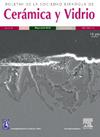bcts基压电陶瓷的特点:从化学基础到加工路线和生物医学应用
IF 2.7
4区 材料科学
Q1 MATERIALS SCIENCE, CERAMICS
Boletin de la Sociedad Espanola de Ceramica y Vidrio
Pub Date : 2025-05-01
DOI:10.1016/j.bsecv.2025.01.003
引用次数: 0
摘要
环境友好型(Ba,Ca)(Zr,Ti)O3陶瓷(BCZT)正在被研究作为一种可行的替代主要的商业使用的钛酸铅-锆酸盐陶瓷。这些铁压电陶瓷在一系列应用中表现出迷人的性能,这取决于几个多尺度特征,包括成分、晶体结构、畴结构、陶瓷微观结构和体积问题。为了提供可重复的质量,彻底掌握加工控制是必不可少的。本文首先回顾了BCZT陶瓷发展的历史概况,然后进行了相图检查。探讨了向形态相边界,详细说明了系统压电性的内在和外在贡献,以及处理时要考虑的关键方面。回顾了工业上可扩展的固态处理途径需要考虑的因素,重点是机械激活。此外,还分析了用于BCZT合成和烧结的铣削工艺,以及水基可持续加工。评估的结论是生物技术在医疗方面的新用途的前景。本文章由计算机程序翻译,如有差异,请以英文原文为准。
Hallmarks of BCZT-based piezoceramics: From chemical fundamental to processing route and biomedical applications
Environmentally friendly (Ba,Ca)(Zr,Ti)O3 ceramics (BCZT) are being investigated as a viable alternative to the leading commercially used lead titanate–zirconate ceramics. These ferro-piezoelectric ceramics exhibit fascinating properties for a range of applications, dependent on several multiscale characteristics, including composition, crystal structure, domain structure, ceramic microstructure and bulk issues. To provide reproducible quality, a thorough grasp of processing control is essential. This review begins with a historical overview of BCZT ceramic development, followed by a phase diagram examination. The morphotropic phase boundary is explored, detailing the intrinsic and extrinsic contributions to the system's piezoelectricity, as well as the critical aspects to consider while processing. The factors to contemplate for an industrially scalable solid state processing pathway are reviewed, with a focus on mechanical activation. Additionally, the milling processes utilized for BCZT synthesis and sintering, as well as water-based sustainable processing, are analysed. The assessment concludes with the promise of emerging uses in biotechnology for medical purposes.
求助全文
通过发布文献求助,成功后即可免费获取论文全文。
去求助
来源期刊

Boletin de la Sociedad Espanola de Ceramica y Vidrio
工程技术-材料科学:硅酸盐
CiteScore
5.50
自引率
2.90%
发文量
72
审稿时长
103 days
期刊介绍:
The Journal of the Spanish Ceramic and Glass Society publishes scientific articles and communications describing original research and reviews relating to ceramic materials and glasses. The main interests are on novel generic science and technology establishing the relationships between synthesis, processing microstructure and properties of materials. Papers may deal with ceramics and glasses included in any of the conventional categories: structural, functional, traditional, composites and cultural heritage. The main objective of the Journal of the Spanish Ceramic and Glass Society is to sustain a high standard research quality by means of appropriate reviewing procedures.
 求助内容:
求助内容: 应助结果提醒方式:
应助结果提醒方式:


